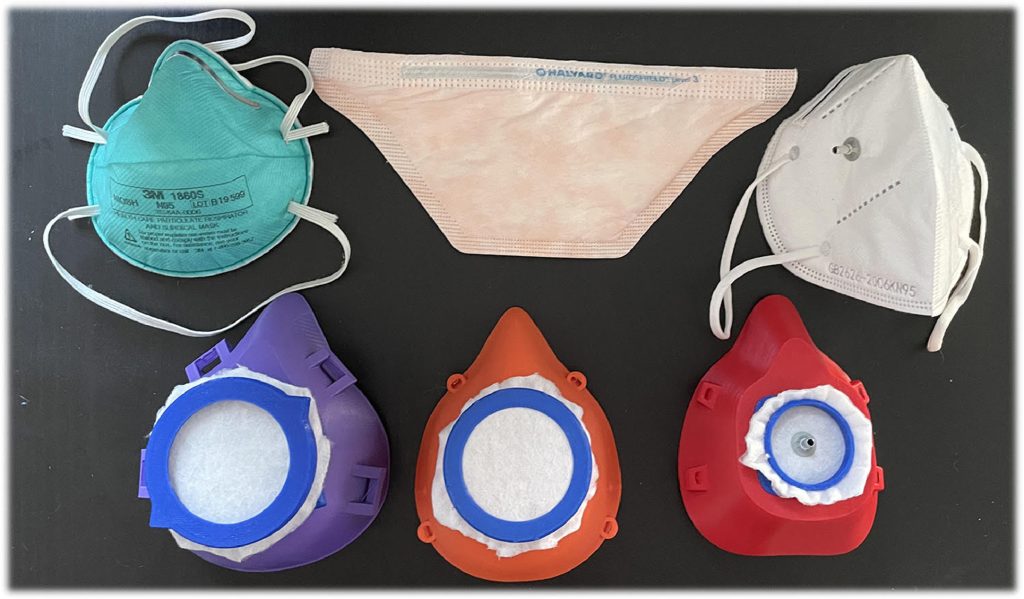Researchers from the US are investigating the use of low-cost 3D printed masks in the fight against COVID-19.
N95 respirators have proven themselves to be one of the most effective ways of stopping the transmission of respiratory diseases. However, initial shortages in N95 supplies meant a search for viable alternatives.
The thinking was that a 3D printed respirator MIGHT have advantages over a conventionally manufactured N95, including a lower cost of production (at low volumes), faster production cycles, reusability, and of course, customizability. Although STL files for 3D printed masks grew in popularity around the start of the pandemic, there’s still little data to support them as a feasible alternative to the N95.

Fit-testing the 3D printed masks
The ultimate aim of the investigation was to compare how well a 3D printed mask would fit onto a variety of face shapes when compared to the tried-and-tested N95. To kick the project off, the researchers selected five healthy medical students to participate in a series of fit tests. The participants’ facial measurements were taken from the bridge of the nose to the chin (height), and again from the tip of the nose to the ears (width).
The researchers then found three of the most popular 3D printed mask designs on sites such as MyMiniFactory, an online 3D file marketplace. They downloaded the part files, sliced them according to the recommended settings, and 3D printed them using low-cost polymer materials such as PLA and TPU.
To fit the 3D printed masks onto the medical students, the researchers heated the respirators using a hair dryer and instructed the participants to press them against their faces to mold the contours.
Fit testing was subsequently performed using a particle generator and a particle counter, whereby saline was dispersed into the air and the concentrations were measured inside the masks. The participants also underwent standardized fit tests with traditional N95s and KN95s to compare the results.
The study involved a total of four fit tests in accordance with OSHA protocols. Each of the tests was designed to simulate the movements a mask wearer might experience on a day-to-day basis, including 50 seconds of leaning forward, 30 seconds of speaking, 30 seconds of shaking the head from side to side, and 30 seconds of nodding.

How did the masks stack up?
Looking at the results, only one of the 3D printed masks (Low Poly Covid-19 Face Mask Respirator, Mask 2) achieved a sufficient fit factor of more than 100 in all of the trials. This represented a ‘pass’ according to the OSHA protocols with both PLA and TPU. The researchers also found no effect on the fit factor when the filter for Mask 2 was substituted out for a 95% HEPA filter or for a NIOSH-approved N95 replacement filter.
While the standard 1860S N95 mask only offered a sufficient fit in 60% of the tests, meaning two of the five participants would’ve been exposed to respiratory diseases, the other two 3D printed masks failed to provide a reliable fit factor altogether.
All in all, the work demonstrated that 3D printing could potentially be used to provide a viable alternative to conventional N95s, but finding an adequate design might be tricky. 3D printed masks would also have to be used with an approved filter, calling for some level of regulation to ensure safety. Although the team does hope its findings can pave the way for more efficient respirator designs that fit a wider variety of face shapes, additive manufacturing currently doesn’t offer the productivity needed to fabricate such masks at scale.
Further details of the study can be found in the paper titled ‘Face Off: 3D Printed Masks as a Cost-Effective and Reusable Alternative to N95 Respirators: A Feasibility Study.’
Masks aside, additive manufacturing has proven itself to be an excellent COVID-fighting tool over the course of the pandemic. Just last year, scientists at the Israeli Weizmann Institute of Science 3D printed an ‘electronic nose’ accessory capable of ‘smelling’ the chemicals associated with being infected with COVID-19. The team’s instrument, featuring a gas unit, sensor array, and 3D printed sampling valve, has been trained through practical testing to find COVID-19 and other volatile organic compounds (VOCs) inside patients’ nasal passages.
Elsewhere, researchers at the Dutch Wageningen University (WUR) used 3D printing to develop a COVID-19 home test kit that can be built for less than 20p. Nicknamed ‘CoroNaspresso,’ the team’s device comprises coffee capsules that have been turned into mini chemical reactors, in which heated enzyme-loaded saliva vials change color to indicate the presence of COVID-19.
Subscribe to the 3D Printing Industry newsletter for the latest news in additive manufacturing. You can also stay connected by following us on Twitter, liking us on Facebook, and tuning into the 3D Printing Industry YouTube Channel.
Looking for a career in additive manufacturing? Visit 3D Printing Jobs for a selection of roles in the industry.
Featured image shows the three 3D printed mask designs. Photo via American Journal of Medicine.


